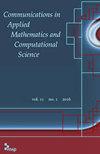可压缩流动中捕捉激波和湍流谱的有限体积方法研究
IF 2.1
3区 数学
Q1 MATHEMATICS, APPLIED
Communications in Applied Mathematics and Computational Science
Pub Date : 2020-06-03
DOI:10.2140/camcos.2020.15.1_
引用次数: 0
摘要
作者:Motheau, E;Wakefield, J |摘要:©Mathematical Sciences Publishers。本文的目的是提供几种不同数值精度的有限演化方法的比较:二阶Godunov方法与PPM插值和高阶有限体积WENO方法。结果表明,在光滑问题上,高阶方法优于二阶方法,但当解中含有激波时,所有方法均降至一阶精度。在具有激波的可压缩均匀各向同性湍流衰减的背景下,尽管在单元界面处使用了五阶重建方案,但方法的实际总体精度降至二阶。最重要的是,无论采用何种数值方法,湍流光谱的结果都是相似的,除了PPM方法无法在光谱的高频范围内提供准确的表示。本文提出了一种新的混合PPM/WENO方法,该方法能够以高阶方法的精度捕获湍流光谱,但以二阶Godunov方法为代价。总的来说,通过使用二阶方法和精心选择的数值过程来改进模拟,而不是运行粗糙的高阶模拟,可以更快地获得几乎相同的物理解。我们的结果表明,根据实际的谱耗散和色散特性来评估数值方法在混合光滑/激波情况下的准确性的重要性,而不是根据理论的收敛速率的形式顺序。本文章由计算机程序翻译,如有差异,请以英文原文为准。
Investigation of finite-volume methods to capture shocks and turbulence spectra in compressible flows
Author(s): Motheau, E; Wakefield, J | Abstract: © Mathematical Sciences Publishers. The aim of the present paper is to provide a comparison between several finitevolume methods of different numerical accuracy: the second-order Godunov method with PPM interpolation and the high-order finite-volume WENO method. The results show that while on a smooth problem the high-order method performs better than the second-order one, when the solution contains a shock all the methods collapse to first-order accuracy. In the context of the decay of compressible homogeneous isotropic turbulence with shocklets, the actual overall order of accuracy of the methods reduces to second-order, despite the use of fifth-order reconstruction schemes at cell interfaces. Most important, results in terms of turbulent spectra are similar regardless of the numerical methods employed, except that the PPM method fails to provide an accurate representation in the high-frequency range of the spectra. It is found that this specific issue comes from the slope-limiting procedure and a novel hybrid PPM/WENO method is developed that has the ability to capture the turbulent spectra with the accuracy of a high-order method, but at the cost of the second-order Godunov method. Overall, it is shown that virtually the same physical solution can be obtained much faster by refining a simulation with the second-order method and carefully chosen numerical procedures, rather than running a coarse high-order simulation. Our results demonstrate the importance of evaluating the accuracy of a numerical method in terms of its actual spectral dissipation and dispersion properties on mixed smooth/shock cases, rather than by the theoretical formal order of convergence rate.
求助全文
通过发布文献求助,成功后即可免费获取论文全文。
去求助
来源期刊

Communications in Applied Mathematics and Computational Science
MATHEMATICS, APPLIED-PHYSICS, MATHEMATICAL
CiteScore
3.50
自引率
0.00%
发文量
3
审稿时长
>12 weeks
期刊介绍:
CAMCoS accepts innovative papers in all areas where mathematics and applications interact. In particular, the journal welcomes papers where an idea is followed from beginning to end — from an abstract beginning to a piece of software, or from a computational observation to a mathematical theory.
 求助内容:
求助内容: 应助结果提醒方式:
应助结果提醒方式:


